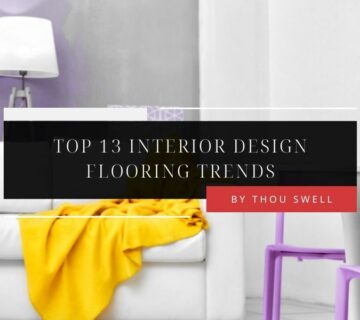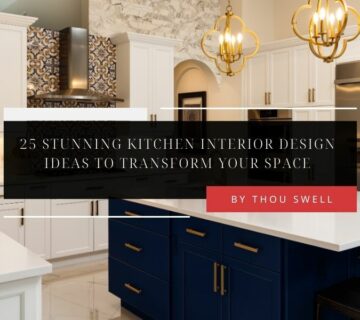Industrial interior design style uniquely blends the raw charm of industrial spaces with modern sophistication. It celebrates exposed brick, metal, and wood, drawing inspiration from warehouses and factories to create spaces that are both elegant and rugged. This style is not just about aesthetics but embodies a philosophy that combines form with function.
In this guide, we dive into the essentials that define this aesthetic. From the importance of exposed elements and metal accents to the role of neutral colors and the balance of vintage with modern, each section offers insights into creating a cohesive industrial-style space.
This guide is your key to unlocking the industrial charm in your home, providing a blend of functionality and minimalism to inspire your design journey. Join us as we explore how to infuse industrial elegance into contemporary living spaces.
What Is Industrial Style Interior Design?
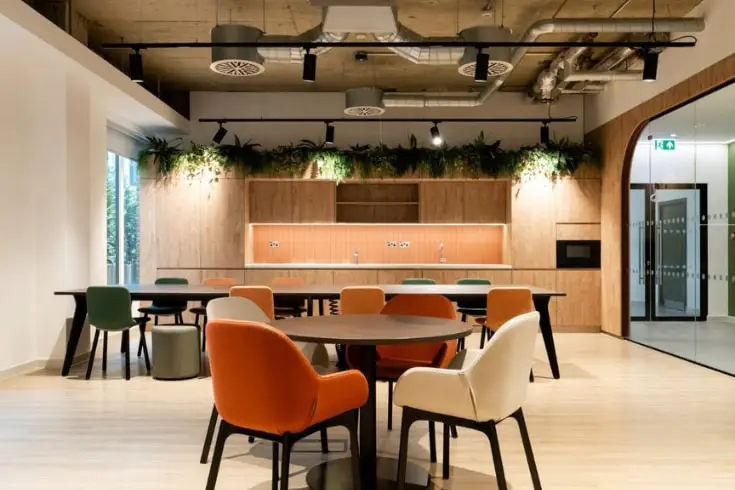
Industrial-style interior design blends vintage charm with modern flair, creating spaces where exposed brick, high ceilings, and metal fixtures shine. Inspired by warehouses and factories, this design repurposes their distinctive elements into chic, functional living areas.
Imagine a loft apartment where the kitchen features stainless steel countertops, open shelving, and pipes are left uncovered as a nod to the space’s industrial heritage. Or a living room where modern sofas are paired with vintage industrial lamps and a coffee table made from reclaimed wood and iron. The beauty of industrial-style interior design lies in its ability to celebrate imperfections—be it in the raw finishes of materials or the deliberate showcasing of structural elements that other design styles might seek to hide.
In essence, industrial-style interior design is about embracing a raw, unfinished look while incorporating a mix of old and new to create spaces that feel both timeless and edgy. It’s a style that tells a story through its use of materials, textures, and the very bones of the building itself, offering a bold, minimalist canvas that homeowners can personalize.
Why Choose Industrial Style for Your Space?
Opting for industrial style in your space is akin to embracing a unique blend of character and functionality. Here’s why it’s a compelling choice:
- Distinct charm: Industrial design’s raw, exposed elements like brick walls and metal fixtures instantly add character and a visually striking aesthetic to any space.
- Versatile: This style is highly adaptable, serving as a neutral canvas that can be personalized with different textures, colors, and decor items, blending seamlessly with other design influences.
- Rich in history: Industrial style celebrates the authenticity and stories of a building, making your space not just a home but a narrative of its past.
- Practicality: Born from efficiency, it offers smart, open layouts with ample natural light and innovative storage solutions, reflecting its factory and warehouse origins.
- Sustainability: Emphasizing repurposing and reclaiming, industrial design is eco-friendly, conserving resources by breathing new life into existing structures and materials.
Choosing industrial design means marrying aesthetics with eco-consciousness, all while crafting a space that’s both stylish and steeped in history.
What Are the Key Characteristics of Industrial Style Interior Design?
Industrial-style interior design is celebrated for its distinctive blend of form and function, drawing inspiration from the utilitarian beauty of old factories and industrial spaces. Here are the key characteristics that define this unique aesthetic:
Essential 1: Exposed Brick and Pipes
A signature feature, exposed brick walls and visible piping pay homage to the raw, unfinished look emblematic of industrial spaces. This element adds texture and a touch of rugged beauty, providing a perfect backdrop that complements the industrial vibe. It’s all about celebrating the imperfections and showcasing the building’s history.
Essential 2: Metal Accents and Fixtures
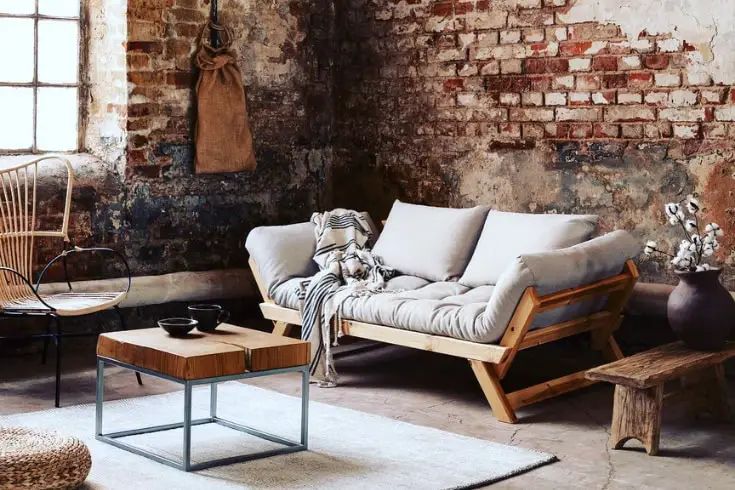
Metal brings a sleek, durable quality to industrial interiors. Whether it’s through brushed nickel, cast iron, or stainless steel, these accents add a modern, edgy contrast to the warmth of wood and the roughness of brick. Look for metal in furniture frames, lighting, or as decorative elements like stair rails and door handles.
Essential 3: Industrial Lighting Fixtures
Lighting plays a key role in defining the space. Industrial fixtures often feature a blend of metal and glass, with designs that reflect vintage factory equipment—think large pendant lights, floor lamps with a minimalist, angular design, and sconces that expose Edison bulbs. These fixtures not only illuminate but also serve as statement pieces.
Essential 4: Neutral and Earth Tone Color Palettes
The color scheme in industrial design is intentionally subdued to let the materials stand out. Neutral tones like gray, beige, off-white, and earthy hues mimic the colors found in industrial buildings and create a serene, cohesive look. Accents in bold colors can add depth and interest without overwhelming the space.
Essential 5: Concrete Flooring
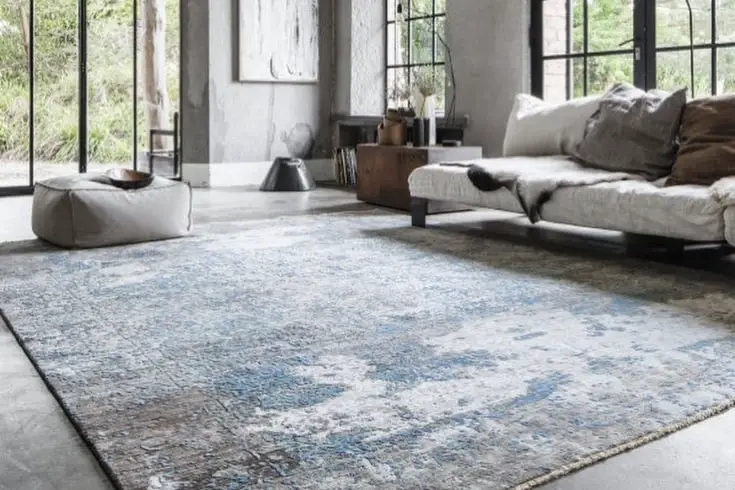
The use of concrete flooring enhances the industrial feel with its smooth, sleek surface that resembles warehouse floors. It’s not only practical and hardwearing but also offers a clean, minimalist base that complements the aesthetic. Area rugs can add warmth and texture to soften the industrial edges.
Essential 6: Vintage Furniture
Integrating vintage furniture pieces contributes an element of warmth and nostalgia, balancing the coolness of metal and concrete. Look for items with a story—aged leather armchairs, reclaimed wood tables, and old metal filing cabinets repurposed as storage solutions. These pieces add character and uniqueness to the space.
Essential 7: Open Floor Plans
Inspired by the spacious, unpartitioned areas of industrial buildings, open floor plans promote a sense of openness and flexibility. This layout encourages interaction and movement, making the space feel larger and more welcoming while allowing for creative partitioning through furniture placement or area rugs.
Essential 8: Raw Wood and Steel
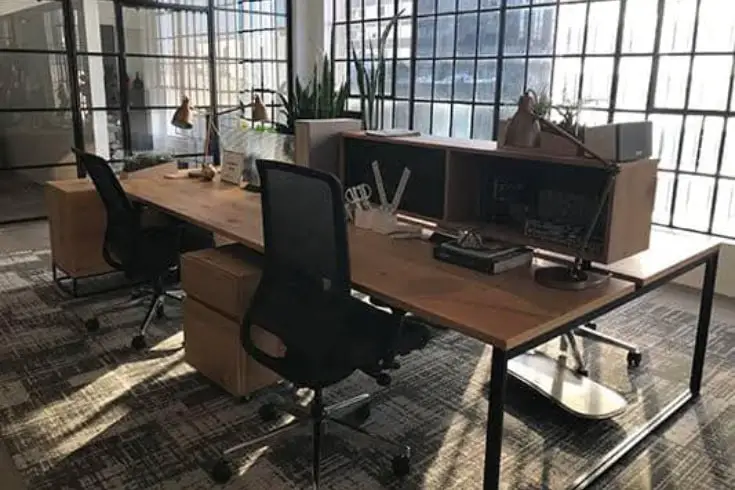
The juxtaposition of wood and steel is central to industrial design, marrying the warmth of natural textures with the cold hardness of metal. Furniture and shelving often showcase this combination, with raw, unfinished wood surfaces supported by steel frames—creating a look that’s both rustic and modern.
Essential 9: Minimalist Decor
Adhering to the principle that less is more, the industrial style emphasizes minimalism in decor. Rather than cluttering the space with knick-knacks, focus on a few key pieces that have purpose and presence. This approach ensures the space feels uncluttered and spacious, with each item carefully selected to contribute to the overall aesthetic.
Incorporating Technology and Modern Comforts
Incorporating technology and modern comforts into industrial-style interior design is essential for transforming these visually appealing spaces into functional, livable environments. The key is to blend the raw, historical essence of the industrial aesthetic with contemporary conveniences seamlessly. Here’s how you can achieve this balance:
- Smart home technology: Embrace smart home gadgets that don’t detract from the industrial vibe. Think sleek, minimalist designs in thermostats, lighting controls, and home assistants. These devices offer modern functionality while maintaining the aesthetic. Mounting them on exposed brick walls or alongside metal elements can integrate technology into the decor rather than it standing out.
- Integrated entertainment systems: Modern entertainment systems can fit neatly into the industrial theme with a little creativity. Mount flat-screen TVs against exposed brick for a striking visual contrast, or house media equipment in minimalist metal or reclaimed wood units. Concealing wires within metal conduits can also add to the industrial look while keeping the space tidy.
- Contemporary kitchen appliances: Stainless steel appliances are a natural fit for industrial kitchens, blending in with metal accents and fixtures. Opt for high-performance, energy-efficient models that offer the modern conveniences you need without sacrificing style. Incorporating smart kitchen gadgets, like Wi-Fi-enabled coffee makers or smart ovens, can add a layer of modern luxury.
- Modern lighting solutions: While industrial lighting fixtures serve as statement pieces, integrating LED technology offers a sustainable and customizable lighting solution. Choose LEDs with adjustable color temperatures to change the ambiance from warm for cozy evenings to bright and cool for work. Modern floor and desk lamps with industrial design elements can provide task lighting without disrupting the aesthetic.
- Comfort through climate control: Industrial spaces can sometimes feel stark or cold. Modern heating and cooling solutions, such as smart thermostats or sleek, efficient heaters, can ensure comfort without the visual clutter. Exposed ductwork can be embraced within the design, enhancing the industrial feel while serving a practical purpose.
- Acoustic enhancements: Industrial designs often feature hard surfaces and high ceilings, which can result in poor sound quality. Incorporate modern sound-absorbing materials creatively, like acoustic panels disguised as artwork or strategically placed modern rugs, to reduce echo and enhance the quality of sound, be it from your entertainment system or conversations.
- Ergonomic furniture with a modern twist: Select furniture that marries industrial aesthetics with modern ergonomics. Think chairs and desks designed for comfort and productivity, upholstered in materials that echo the industrial palette, such as leather or canvas, supported by metal frames. This way, your space remains visually cohesive while being adapted to contemporary living and working needs.
By thoughtfully incorporating these technologies and comforts, you can enjoy the best of both worlds—maintaining the authentic, raw appeal of the industrial style while embracing the efficiency and ease of modern living. This approach ensures your industrial-style space is not only stylish but also a comfortable, functional place for contemporary life.
Related article:
Conclusion
Embracing the industrial interior design style means creating a space that combines raw materials, minimalist decor, and modern comforts with a nod to the industrial era’s architectural heritage.
We’ve explored essential elements like exposed brick, metal accents, and open floor plans, along with tips for integrating technology and comfort into this unique aesthetic.
Whether you’re renovating your home or just adding industrial touches, remember that balancing functionality with style is key. Ready to transform your space? Dive into the industrial design trend today and build a living area that’s both trendy and timeless.
